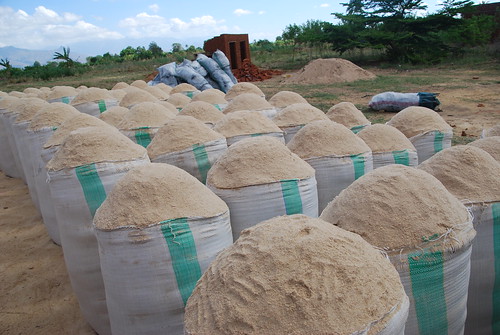Our research for development project is launched today by the International Livestock Research Institute (ILRI) and the International Water Management Institute (IWMI), both members of the CGIAR Consortium (www.cgiar.org). LIVES will directly support of the Government of Ethiopia’s effort to transform smallholder agriculture to be more market-oriented.
Supported by the Canadian International Development Agency (CIDA), the LIVES project is jointly implemented by ILRI, IWMI, the Ethiopian Institute of Agricultural research (EIAR), the Ethiopian Ministry of Agriculture and regional Bureaus of Agriculture, Livestock Development Agencies, Agricultural Research Institutes and other development projects.
LIVES project manager, Azage Tegegne emphasized that this project is unique in that it integrates livestock with irrigated agriculture development. The project is designed to support the commercialization of smallholder agriculture by testing and scaling lessons to other parts of Ethiopia. “It is also excellent opportunity for CGIAR centres to work hand in hand with Ethiopian research and development institutions.”
Ethiopian State Minister of Agriculture H.E. Wondirad Mandefro welcomed the project, asserting that it will directly contribute to both the Growth Transformation Plan (GTP) and the Agricultural Growth Program (AGP) of the Ethiopian Government. Canadian Head of Aid, Amy Baker expects this investment to generate technologies, practices and results that can be implemented at larger scales and ultimately benefit millions of Ethiopian smallholder producers as well as the consumers of their products. Canadian Ambassador David Usher noted that the project will contribute to Ethiopia’s efforts to drive agricultural transformation, improve nutritional status and unlock sustainable economic growth. LIVES is also a reflection of Canada’s commitment to the 2012 G-8 New Alliance for Food and Nutrition Security which will allow Ethiopia, donors and the private sector create new and innovative partnerships that will drive agricultural growth.
LIVES actions will take place over six years in 31 districts of ten zones in Amhara, Oromia, Southern Nations, Nationalities, and Peoples and Tigray regions, where 8% of the country’s human population resides. LIVES will improve the incomes of smallholder farmers through value chains development in livestock (dairy, beef, sheep and goats, poultry and apiculture) and irrigated agriculture (fruits, vegetables and fodder). The project, with a total investment of CAD 19.26 million, aims to directly and indirectly benefit more than 200,000 households engaged in livestock and irrigated agriculture, improve the skills of over 5,000 public service staff, and work with 2,100 value chain input and service suppliers at district, zone and federal levels.
“Projects that support local farmers can help a community in so many ways; not only by providing food and the most appropriate crops, but also by teaching long term skills that can have an impact for years to come,” said Canada Minister of International Cooperation the Honourable Julian Fantino. “The Livestock and Irrigation Value Chains project teaches smallholder farmers new agricultural techniques and provides technical assistance, training, and mentoring to government specialists. They in turn will provide production and marketing assistance to local farmers. This is a project that helps all areas of farming and agriculture development.”
The project will focus on clusters of districts, developing and improving livestock production systems and technologies in animal breeding, feed resources, animal nutrition and management, sustainable forage seed systems, sanitation and animal health, and higher market competitiveness. Potential irrigated agriculture interventions include provision of new genetic materials, development of private seedling nurseries, work on seed systems, irrigation management, water use efficiency, water management options, crop cycle management, and pump repair and maintenance.
The main components of the project are capacity development, knowledge management, promotion, commodity value chain development, and documentation of tested and successful interventions. Gender and the environment will be integrated and mainstreamed in all components of the project.
Some photos from the launch event
The Livestock and Irrigation Value chains for Ethiopian Smallholders (LIVES) project contributes to enhanced income and gender equitable wealth creation for smallholders and other value chain actors in Ethiopia through increased and sustained market off-take of high value livestock and irrigated crop commodities.
LIVES is jointly implemented by by ILRI (the International Livestock Research Institute), IWMI (the International Water Management Institute), the Ethiopian Institute of Agricultural research (EIAR), the Ethiopian Ministry of Agriculture and regional Bureaus of Agriculture, Livestock Development Agencies, Agricultural Research Institutes and other development projects.







































